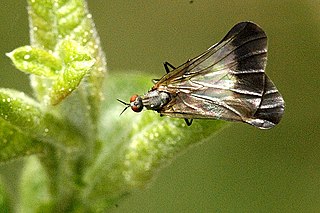
The Empidoidea are a large monophyletic superfamily of true flies, the sister taxon to the Muscomorpha (Cyclorrhapha). These two groups are sometimes united in the unranked taxon Eremoneura. There are some 10,000 known species within Empidoidea, which are represented on all continents except Antarctica. They are known to have existed since the Jurassic period.

Empididae is a family of flies with over 3,000 described species occurring worldwide in all the biogeographic realms but the majority are found in the Holarctic. They are mainly predatory flies like most of their relatives in the Empidoidea, and exhibit a wide range of forms but are generally small to medium-sized, non-metallic and rather bristly.

Trichopezinae are a subfamily of empidoid flies. They are mainly predatory flies like most of their relatives, and generally small to medium-sized, long-legged and large-eyed.

Empis is a genus of dance fly found in the fly family Empididae.

Rhamphomyia is a genus of dance flies, in the fly family Empididae. It contains more than 600 species in 8 subgenera.

Hemerodromiinae are a worldwide group of predatory flies in the family Empididae with raptorial forelegs.

Brachystomatinae is a subfamily of flies belonging to the family Empididae.

Clinocerinae is a subfamily of flies belonging to the family Empididae.

Empidinae, also called dance flies, are a subfamily of empidoid flies. They are mainly predatory flies like most of their relatives, and generally small to medium-sized. Most species are flower visitors and they can be effective pollinators.

Phyllodromia is a genus of dance flies. There are about 10 described species in Phyllodromia.

Ragadidae is a family of true flies in the superfamily Empidoidea. It was formerly considered a lower taxon, but was published as a new subfamily within Empididae in 2016. Since then, it has been classified as the sister group to Empididae, and has been elevated to family level based on the genetic differences which separate it from Empididae.
Wiedemannia is a genus of flies in the family Empididae.
Hilarempis is a genus of flies in the family Empididae.
Macrostomus is a genus of flies in the family Empididae.
Opeatocerata is a genus of flies in the family Empididae.
Drymodromia is a genus of flies in the family Empididae.
Opeatocerata cooperi is a species of dance flies, in the fly family Empididae.
Opeatocerata lopesi is a species of dance flies, in the fly family Empididae.
Opeatocerata melanderi is a species of dance flies, in the fly family Empididae.
Opeatocerata trilobata is a species of dance flies, in the fly family Empididae.








